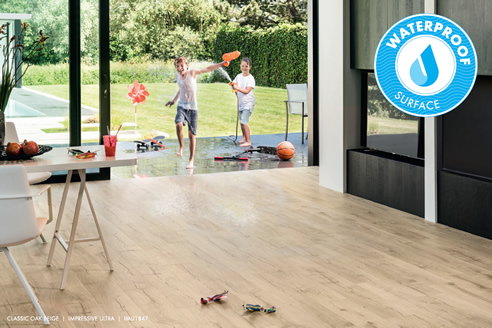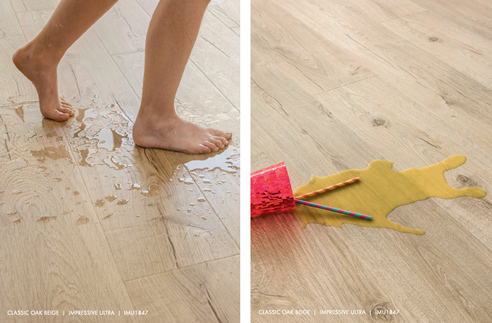Water-Resistant Floors from Premium Floors

RAISING THE BAR FOR WATER-RESISTANT LAMINATE: QUICK-STEP®'S CASE FOR NEW STANDARDS.
How do you test the water-resistance of laminate? The water tightness of laminate is assessed through a swelling test. Floorboard samples are submerged in water and measured for swelling. The problem with this method? "It only tests the water resistance of the individual boards; not that of the installed floor as a whole", says Kendall Waller, National Product Manager. "That's why we've developed our own tests - which are more accurate, stricter and, above all, representative of real-life situations."
MOPPING THE FLOOR WITH IMPERMEABILITY
One way to test whether an installed laminate floor is watertight is through a mop test. Kendall explains: "This lab test consists of covering the installed floor with wet mops for 14 hours. We don't just use water, but also add soap. This makes for a more rigid trial, as soap reduces the water's surface tension. Then we assess: Is water seeping through the joints? Is there any surface damage or swelling?"
NOTHING SLIPS THROUGH THE CRACKS
An equally strict - if not stricter - evaluation of a floor's water resistance is Quick-Step's cylinder test. "By placing a cylinder on the T-shaped connections of installed floorboards and filling it with water and soap, the bevels and installation quality are put to the test", Kendall explains. "After 4, 12 or even 24 hours, swelling is measured and assessed. We have never seen an increase of over 0.05 mm. In addition, the permeability of all points of contact is analyzed. And we're also testing with other fluids than water and soap - e.g. wine and pet urine - but our floors still score equally well."

KEEPING THE REAL-LIFE END USE IN MIND
Quick-Step's real-life trial was developed to test floors in actual situations: a leaking washing machine, a spilled drink,
a urinating pet, etc. "Analyses like the standard swelling test aren't relevant to the end customer because they don't test
installed floors in real-life circumstances", Kendall points out. "Our real-life tests do. What if you're bathing the children
and they won't stop splashing?"
QUICK-STEP'S ADVANCED TRIPARTITE TECHNOLOGY
Waterproofing a bevelled floating floor is quite the challenge. In the case of an installed bevelled laminate floor, water
can easily seep through the joints. Quick-Step solves this through a waterproofing technology that is based on three
pillars: compressing the floorboards' bevels or edges during production, adding a water-repellent coating and using
click installation systems with pre-tension. "When it comes to bevelled laminate floors, all three elements are crucial for a
100% waterproof end result", Kendall explains.
ALWAYS INNOVATING
Quick-Step strongly invests in innovation. "At the moment, we're researching ways in which we can apply water tightness
technologies developed for bevelled laminate floors to other products, like our non-bevelled floors", Kendall says. "For
those floors, the points of connection between floorboards are equally important for a waterproof end result. Through
our creativity and expertise, we're constantly taking the development of future-proof floors further."
Discover the latest Quick-Step water-resistant floors! Now featured on a range of products including the all-new
Majestic, Colonial Plus and Eligna ranges, as well as the famous Impressive Ultra floors.


|







 Water-resistant Laminate Flooring from
Water-resistant Laminate Flooring from Rigid Vinyl High-Performance Flooring
Rigid Vinyl High-Performance Flooring Flooring for Scandinavian Interiors from
Flooring for Scandinavian Interiors from New Rigid Vinyl Plank Flooring - Titan
New Rigid Vinyl Plank Flooring - Titan Quality Flooring Australia from Premium
Quality Flooring Australia from Premium Quick-Step Intenso Timber Flooring |
Quick-Step Intenso Timber Flooring | Timber Floor Moisture Protection |
Timber Floor Moisture Protection | Waterproof Timber Laminate Flooring |
Waterproof Timber Laminate Flooring | Stable Vinyl Flooring by Quick-Step |
Stable Vinyl Flooring by Quick-Step | Minimise Allergies with Quick-Step
Minimise Allergies with Quick-Step Flooring for Scandinavian Interiors |
Flooring for Scandinavian Interiors | Timber Laminate Flooring | Premium
Timber Laminate Flooring | Premium Timber Floor Colour Range by Quick-Step
Timber Floor Colour Range by Quick-Step Sustainable Floor Manufacturing by
Sustainable Floor Manufacturing by Timber Look Laminate by Quick-Step |
Timber Look Laminate by Quick-Step | Timber Look Vinyl Flooring by Quick-Step
Timber Look Vinyl Flooring by Quick-Step Bedroom Flooring with Quick-Step |
Bedroom Flooring with Quick-Step | Laminate & Timber Flooring on Walls
Laminate & Timber Flooring on Walls Spring Style for Flooring from Premium
Spring Style for Flooring from Premium Engineered Wooden Flooring by Quick-Step
Engineered Wooden Flooring by Quick-Step
